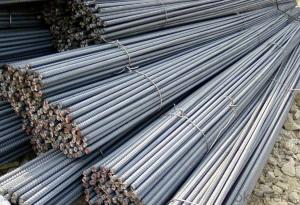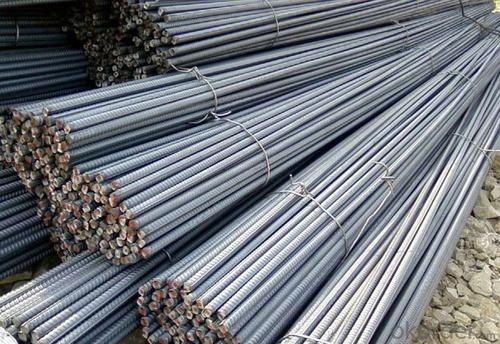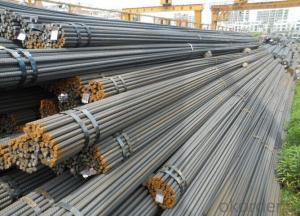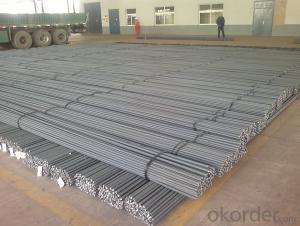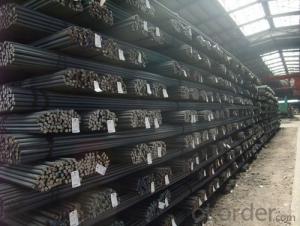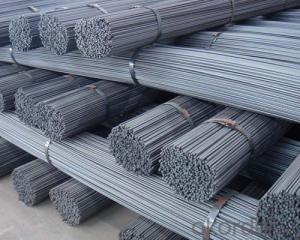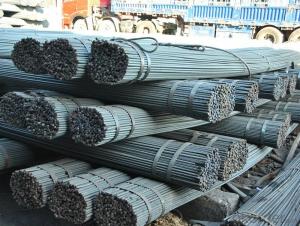Steel Rebar Strips For Building Construction
- Loading Port:
- China main port
- Payment Terms:
- TT OR LC
- Min Order Qty:
- 100 m.t.
- Supply Capability:
- 100000 m.t./month
OKorder Service Pledge
OKorder Financial Service
You Might Also Like
Usage and Applications
Deformed bar is widely used in buildings, bridges, roads and other engineering construction. Big to highways, railways, bridges, culverts, tunnels, public facilities such as flood control, dam, small to housing construction, beam, column, wall and the foundation of the plate, deformed bar is an integral structure material. With the development of world economy and the vigorous development of infrastructure construction, real estate, the demand for deformed bar will be larger and larger.
Diameter(mm) | Section area (mm²) | Mass(kg/m) | Weight of 12m bar(kg) |
6 | 28.27 | 0.222 | 2.664 |
8 | 50.27 | 0.395 | 4.74 |
10 | 78.54 | 0.617 | 7.404 |
12 | 113.1 | 0.888 | 10.656 |
14 | 153.9 | 1.21 | 14.52 |
16 | 201.1 | 1.58 | 18.96 |
18 | 254.5 | 2.00 | 24 |
20 | 314.2 | 2.47 | 29.64 |
22 | 380.1 | 2.98 | 35.76 |
25 | 490.9 | 3.85 | 46.2 |
28 | 615.8 | 4.83 | 57.96 |
32 | 804.2 | 6.31 | 75.72 |
36 | 1018 | 7.99 | 98.88 |
40 | 1257 | 9.87 | 118.44 |
50 | 1964 | 15.42 | 185.04 |
Packaging & Delivery
Packaging Detail: products are packed in bundle and then shipped by container or bulk vessel, deformed bar is usually naked strapping delivery, when storing, please pay attention to moisture proof. The performance of rust will produce adverse effect.
Each bundle weight: 2-3MT, or as required
Payment term: TT or L/C
Delivery Detail: within 45 days after received advanced payment or LC.
Label: to be specified by customer, generally, each bundle has 1-2 labels
Trade terms: FOB, CFR, CIF
Cold Rolled Techniques
Yield Point: 545-565mpa
Deformed bar is widely used in buildings, bridges, roads and other engineering construction. Big to highways, railways, bridges, culverts, tunnels, public facilities such as flood control, dam, small to housing construction, beam, column, wall and the foundation of the plate, deformed bar is an integral structure material. With the development of world economy and the vigorous development of infrastructure construction, real estate, the demand for deformed bar will be larger and larger.
- Q: Are there any environmental concerns related to steel rebars?
- Yes, there are some environmental concerns related to steel rebars. The production of steel involves the extraction of iron ore, which can lead to habitat destruction and deforestation. Additionally, the steel industry is known to be a significant contributor to greenhouse gas emissions. However, steel rebars are a common and necessary material in construction, and efforts are being made to mitigate these environmental impacts through recycling and energy-efficient production methods.
- Q: What are the safety precautions to be taken while handling steel rebars?
- When handling steel rebars, it is important to follow several safety precautions. Firstly, always wear appropriate personal protective equipment (PPE) such as gloves, safety glasses, and steel-toed boots to protect against potential injuries. Secondly, ensure that the work area is clear of any obstacles or tripping hazards. Additionally, use proper lifting techniques and equipment, such as cranes or forklifts, to avoid strain or back injuries. It is crucial to inspect the rebars for any defects or damages before handling them. Lastly, communicate and coordinate with coworkers to ensure a safe working environment and prevent accidents.
- Q: Are steel rebars resistant to chemical exposure?
- Chemical exposure is usually not a problem for steel rebars due to their resistance. The strength and durability of steel make it less likely to corrode or degrade when it comes into contact with chemicals. However, some chemicals can still harm steel rebars. For instance, acids like sulfuric acid can gradually corrode steel and weaken its structure. Similarly, highly alkaline substances can also cause corrosion in steel rebars. Therefore, even though steel rebars are generally resistant to various chemicals, it is crucial to consider the specific chemical environment and take necessary precautions to safeguard them from potential damage.
- Q: How to recognize high quality thread steel
- Inferior steel due to poor production conditions, bulk, no metal signs, no quality guarantee. For safety reasons, we should not buy the inferior steel bars, or go to the direct agents of some famous brand manufacturers, so that the quality is guaranteed. Shandong hundred fertile Steel Pipe Co., Ltd. here recommends that users in the purchase of thread steel, must go to the formal steel business units to purchase, request steel quality certificate, and acceptance.
- Q: How are steel rebars inspected for quality on construction sites?
- In construction projects, steel rebars play a critical role by providing reinforcement and strength to concrete structures. It is crucial to ensure the quality of steel rebars in order to guarantee the safety and durability of the overall construction. To inspect the quality of steel rebars on construction sites, various methods are commonly used. The first and most basic method of quality inspection is visual examination. This involves visually inspecting the rebars for any visible defects such as cracks, deformations, rust, or surface irregularities. Any rebars with such flaws are immediately identified and rejected. Another method involves measuring and checking the dimensions of the rebars. Inspection personnel use measuring tools like calipers or tape measures to verify the length, diameter, and other dimensions of the rebars. Any deviation from the specified tolerances may result in rejection. Magnetic Particle Testing (MPT) is a non-destructive testing method that is commonly employed to detect surface and near-surface defects in steel rebars. In this technique, the rebar is magnetized and ferromagnetic particles are applied, which accumulate at any surface defects or cracks. Trained inspectors carefully examine the surface to identify any areas of concern. Ultrasonic Testing (UT) is another non-destructive testing method used for inspecting rebars. It involves transmitting ultrasonic waves through the rebar. These waves reflect back differently when they encounter defects like voids, cracks, or inclusions. Trained technicians analyze the reflected waves to identify and assess the quality of the rebars. Tensile Testing is carried out to determine the tensile strength of the rebars, which is crucial in assessing their quality. A sample rebar is pulled until it breaks, and the force required to do so is measured. This test helps determine the strength and ductility of the rebar, ensuring it meets the required standards. Chemical analysis is often conducted on steel rebars to ensure they meet the specified composition requirements. Samples are collected from the rebars, and various tests are performed to determine the chemical composition, including carbon, manganese, and other alloying elements. This analysis helps ensure that the rebars possess the necessary properties for the intended application. These inspection methods are typically carried out by qualified and experienced personnel, such as certified welding inspectors or quality control technicians. By implementing these quality inspection procedures, construction sites can ensure that the steel rebars used in their projects meet the required standards, thereby ensuring the safety and longevity of the structures being constructed.
- Q: Can steel rebars be used in road construction?
- Yes, steel rebars can be used in road construction. They are commonly used to reinforce concrete in roadways, providing enhanced strength and durability to withstand heavy traffic loads and prevent cracking. The rebars help distribute the load evenly and minimize the risk of structural failure, making them a crucial component in road construction.
- Q: Can steel rebars be used in high-traffic flooring applications?
- Yes, steel rebars can be used in high-traffic flooring applications. Steel rebars are known for their strength and durability, making them an ideal choice for areas with heavy foot traffic. They provide added support and reinforcement to the flooring, ensuring its longevity and ability to withstand the wear and tear of high-traffic environments.
- Q: How do steel rebars impact the overall aesthetics of concrete structures?
- Steel rebars have a significant impact on the overall aesthetics of concrete structures. While concrete is known for its strength and durability, it lacks the tensile strength to resist bending or stretching forces. This is where steel rebars come into play. By reinforcing concrete with steel rebars, the structural integrity of the concrete is greatly enhanced. This allows engineers and architects to design more complex and ambitious structures, such as high-rise buildings, bridges, and stadiums. The use of steel rebars provides the necessary strength and flexibility to withstand heavy loads, seismic activity, and other environmental forces. However, the presence of steel rebars can affect the appearance of the concrete structure. In some cases, particularly in exposed concrete finishes, the visibility of steel rebars can be seen as a visual distraction or an undesirable element. The exposed steel rebars may create a grid-like pattern or a rusty appearance, which can be perceived as unattractive or out of harmony with the surrounding environment. To mitigate this aesthetic impact, various techniques are employed. One common approach is to use concrete coverings or coatings to hide the steel rebars and create a smooth and uniform surface. These coverings not only serve the purpose of improving the appearance but also provide protection against corrosion and extend the lifespan of the structure. Another method is to employ decorative techniques such as formwork or molds to create unique patterns or textures on the concrete surface. This way, the steel rebars are concealed within the design, adding to the overall aesthetic appeal of the structure. By incorporating architectural features, such as curves or geometric shapes, the presence of steel rebars can be turned into a visual asset rather than a hindrance. It is worth noting that in certain architectural styles, such as Brutalism, the raw and exposed nature of concrete structures, including the visibility of steel rebars, is celebrated as an artistic expression. In these cases, the industrial and utilitarian aesthetic is embraced, and the steel rebars become an integral part of the overall design concept. In conclusion, steel rebars have a significant impact on the aesthetics of concrete structures. While their presence can sometimes be seen as an obstacle to achieving a desired visual outcome, various techniques and design approaches can be employed to either conceal or incorporate steel rebars into the overall architectural design, resulting in aesthetically pleasing and structurally sound concrete structures.
- Q: Can steel rebars be used in foundation repair work?
- Yes, steel rebars can be used in foundation repair work. Steel rebars are commonly used in reinforced concrete structures, including foundations, to provide additional strength and stability. They help to reinforce and strengthen the foundation, making it more resistant to cracks and structural damage.
- Q: What is the minimum yield strength of steel rebars?
- The minimum yield strength of steel rebars is typically around 40,000 pounds per square inch (psi).
Send your message to us
Steel Rebar Strips For Building Construction
- Loading Port:
- China main port
- Payment Terms:
- TT OR LC
- Min Order Qty:
- 100 m.t.
- Supply Capability:
- 100000 m.t./month
OKorder Service Pledge
OKorder Financial Service
Similar products
Hot products
Hot Searches
Related keywords
